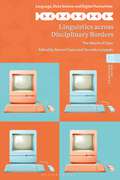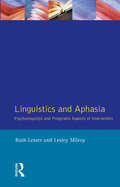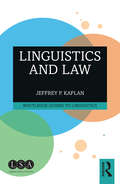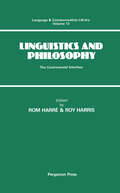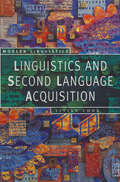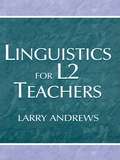- Table View
- List View
Linguistics: An Introduction - Answer Key (Pacific Linguistics Ser. #Vol. 591)
by William B. McGregorThis is the new edition of Linguistics: An Introduction. It is a bestselling introductory textbook for all students of linguistics and language studies. This reworked edition features: -new chapters on sign languages, writing, and text and discourse-coverage of writing in electronic media-revised and updated chapters on languages of the world and psycholinguisticsFirmly based around taught courses and catering to student needs, it addresses all the topics that a student will need in their study of language. With key terms, further reading, questions at the end of each chapter, exercises and key paragraphs in stand-out boxes, this is a firmly pedagogic text that takes difficult concepts and explains them in an easy to understand way. It features examples taken from a range of languages across the world. Global in its scope and comprehensive in its coverage, this is the textbook of choice for linguistics students. The book comes with a large Companion Website, also extensively revised and expanded. For lecturers and instructors, a comprehensive Answer Book is also available to go along with the questions throughout the chapters.
Linguistics: Why It Matters (Why It Matters #15)
by Geoffrey K. PullumLanguage is the medium in which we humans compose our thoughts, explain our thinking, construct our arguments, and create works of literature. Without language, societies as complex as ours could not exist. Geoffrey Pullum offers a stimulating introduction to the many ways in which linguistics, as the scientific study of language, matters. With its close relationships to psychology, education, philosophy, and computer science, the subject has a compelling human story to tell about the ways in which different societies see and describe the world, and its far-reaching applications range from law to medicine and from developmental psychology to artificial intelligence. Introducing Polity’s Why It Matters series: In these short and lively books, world-leading thinkers make the case for the importance of their subjects and aim to inspire a new generation of students.
Linguistics: An Introduction (PDF)
by Andrew Radford Martin Atkinson David Britain Harald Clahsen Andrew SpencerWritten by a team based at one of the world's leading centres for linguistic teaching and research, the second edition of this highly successful textbook offers a unified approach to language, viewed from a range of perspectives essential for students' understanding of the subject. Using clear explanations throughout, the book is divided into three main sections: sounds, words, and sentences. In each, the foundational concepts are introduced, along with their application to the fields of child language acquisition, psycholinguistics, language disorders, and sociolinguistics, giving the book a unique yet simple structure that helps students to engage with the subject more easily than other textbooks on the market. This edition includes a completely new section on sentence use, including an introduction and discussion of core areas of pragmatics and conversational analysis; coverage of sociolinguistic topics, introducing communities of practice; a wealth of new exercise material and updated further reading.
Linguistics across Disciplinary Borders: The March of Data (Language, Data Science and Digital Humanities)
by Steven Coats and Veronika LaippalaThis volume highlights the ways in which recent developments in corpus linguistics and natural language processing can engage with topics across language studies, humanities and social science disciplines.New approaches have emerged in recent years that blur disciplinary boundaries, facilitated by factors such as the application of computational methods, access to large data sets, and the sharing of code, as well as continual advances in technologies related to data storage, retrieval, and processing. The “march of data” denotes an area at the border region of linguistics, humanities, and social science disciplines, but also the inevitable development of the underlying technologies that drive analysis in these subject areas.Organized into 3 sections, the chapters are connected by the underlying thread of linguistic corpora: how they can be created, how they can shed light on varieties or registers, and how their metadata can be utilized to better understand the internal structure of similar resources. While some chapters in the volume make use of well-established existing corpora, others analyze data from platforms such as YouTube, Twitter or Reddit. The volume provides insight into the diversity of methods, approaches, and corpora that inform our understanding of the “border regions” between the realms of data science, language/linguistics, and social or cultural studies.
Linguistics across Disciplinary Borders: The March of Data (Language, Data Science and Digital Humanities)
This volume highlights the ways in which recent developments in corpus linguistics and natural language processing can engage with topics across language studies, humanities and social science disciplines.New approaches have emerged in recent years that blur disciplinary boundaries, facilitated by factors such as the application of computational methods, access to large data sets, and the sharing of code, as well as continual advances in technologies related to data storage, retrieval, and processing. The “march of data” denotes an area at the border region of linguistics, humanities, and social science disciplines, but also the inevitable development of the underlying technologies that drive analysis in these subject areas.Organized into 3 sections, the chapters are connected by the underlying thread of linguistic corpora: how they can be created, how they can shed light on varieties or registers, and how their metadata can be utilized to better understand the internal structure of similar resources. While some chapters in the volume make use of well-established existing corpora, others analyze data from platforms such as YouTube, Twitter or Reddit. The volume provides insight into the diversity of methods, approaches, and corpora that inform our understanding of the “border regions” between the realms of data science, language/linguistics, and social or cultural studies.
Linguistics and Aphasia: Psycholinguistic and Pragmatic Aspects of Intervention
by Ruth Lesser Lesley MilroyLinguistics and Aphasia is a major study of recent developments in applying psycholinguistics and pragmatics to the study of acquired language disorders (aphasia) and their remediation. Psycholinguistic analyses of aphasia interpret disorders in terms of damaged modules and processes within what was once a normal language system. These analyses have progressed to the point that they now routinely provide a model-based rationalefor planning patient therapy. Through a series of case studies, the authors show how the psycholinguistic analysis of aphasia can be assessed for its effectiveness in clinical practice.Pragmatic approaches to the study of aphasia are of more recent origin. Ruth Lesser and Lesley Milroy evaluate their considerable significance to the study of aphasia and their relevance to practical issues of diagnosis and treatment. Controversial analysis, in particular, offers a fruitful and productive framework within which to assess the functional adequacy of the language used by aphasic speakers in everyday contexts.
Linguistics and Aphasia: Psycholinguistic and Pragmatic Aspects of Intervention
by Ruth Lesser Lesley MilroyLinguistics and Aphasia is a major study of recent developments in applying psycholinguistics and pragmatics to the study of acquired language disorders (aphasia) and their remediation. Psycholinguistic analyses of aphasia interpret disorders in terms of damaged modules and processes within what was once a normal language system. These analyses have progressed to the point that they now routinely provide a model-based rationalefor planning patient therapy. Through a series of case studies, the authors show how the psycholinguistic analysis of aphasia can be assessed for its effectiveness in clinical practice.Pragmatic approaches to the study of aphasia are of more recent origin. Ruth Lesser and Lesley Milroy evaluate their considerable significance to the study of aphasia and their relevance to practical issues of diagnosis and treatment. Controversial analysis, in particular, offers a fruitful and productive framework within which to assess the functional adequacy of the language used by aphasic speakers in everyday contexts.
Linguistics and Law (Routledge Guides to Linguistics)
by Jeffrey P. KaplanLinguistics and Law offers a clear and concise introduction to making sense of the law through linguistics. Drawing on lexical semantics, syntax, and pragmatics to interpret both written and spoken laws, this book: addresses how to interpret legal documents such as contracts, statutes, constitutional provisions and trademarks; provides thorough analyses of "language crimes" including solicitation, perjury, defamation, and conspiracy, as well as talk between police and criminal suspects; analyzes the Miranda warning in depth; tackles the question of whether there is a "language" of the law; draws on real-life case studies to aid understanding. Written in an approachable, conversational style and aimed at undergraduate students with little or no prior knowledge of linguistics or law, this book is essential reading for those approaching this topic for the first time.
Linguistics and Law (Routledge Guides to Linguistics)
by Jeffrey P. KaplanLinguistics and Law offers a clear and concise introduction to making sense of the law through linguistics. Drawing on lexical semantics, syntax, and pragmatics to interpret both written and spoken laws, this book: addresses how to interpret legal documents such as contracts, statutes, constitutional provisions and trademarks; provides thorough analyses of "language crimes" including solicitation, perjury, defamation, and conspiracy, as well as talk between police and criminal suspects; analyzes the Miranda warning in depth; tackles the question of whether there is a "language" of the law; draws on real-life case studies to aid understanding. Written in an approachable, conversational style and aimed at undergraduate students with little or no prior knowledge of linguistics or law, this book is essential reading for those approaching this topic for the first time.
Linguistics and Literacy (Topics in Language and Linguistics)
by Wiliam FrawleyWilliam Frawley University of Delaware Several years ago, I performed a kind of perverse experiment. I showed, to several linguistic colleagues, the following comment made by Walker Percy (in The Message in the Bottle): language is too important a problem to be left only to linguists. The linguists' responses were peculiarly predictable: "What does Percy know? He's a mercenary outsider, a novelist, a psychiatrist! How can he say something like that?" Now, it should be known that the linguists who said such things in response were ardent followers of the linguistic vogue: to cross disciplines at whim for the sake of explanation---any explanation. It was odd, to say the least: Percy was damned by the very people who agreed with him! Fortunately, the papers in this book, though radically interdisciplinary, do not fall prey to the kind of hypocrisy described above. The papers (from the Third Delaware Symposium on Language Studies) address the question of literacy---a linguistic problem too important to be left only to linguists--but many of the authors are not linguists at all, and those who are linguists have taken the care to see beyond the parochialism of a single discipline. The subsequent papers have been written by psychologists, linguists, anthropologists, computer scientists, and language teachers to explain the problem of how humans develop, comprehend, and produce extended pieces of informa tion (discourses and texts).
Linguistics and Literary History: Essays in Stylistics
by Leo SpitzerSpitzer discusses the method he evolved for bringing together the two disciplines, linguistics and literary history, and examines the work of Cervantes, Racine, Diderot, and Claudel in the light of this theory.Originally published in 1967.The Princeton Legacy Library uses the latest print-on-demand technology to again make available previously out-of-print books from the distinguished backlist of Princeton University Press. These editions preserve the original texts of these important books while presenting them in durable paperback and hardcover editions. The goal of the Princeton Legacy Library is to vastly increase access to the rich scholarly heritage found in the thousands of books published by Princeton University Press since its founding in 1905.
Linguistics and Novel
by Roger FowlerFirst Published in 2002. Routledge is an imprint of Taylor & Francis, an informa company.
Linguistics and Novel
by Roger FowlerFirst Published in 2002. Routledge is an imprint of Taylor & Francis, an informa company.
Linguistics and Philosophy: The Controversial Interface (Language and Communication Library #Volume 13)
by R. Harré R. HarrisAs hopes that generative linguistics might solve philosophical problems about the mind give way to disillusionment, old problems concerning the relationship between linguistics and philosophy survive unresolved. This collection surveys the historical engagement between the two, and opens up avenues for further reflection. In Part 1 two contrasting views are presented of the interface nowadays called 'philosophy of linguistics'. Part 2 gives a detailed historical survey of the engagement of analytic philosophy with linguistic problems during the present century, and sees the imposition by philosophers of an 'exploratory' model of thinking as a major challenge to the discipline of linguistics. Part 3 poses the problem of whether linguistics is dedicated to describing independently existing linguistic structures or to imposing its own structures on linguistic phenomena. In Part 4 Harris points out some similarities in the way an eminent linguist and an eminent philosopher invoke the analogy between languages and games; while Taylor analyses the rationale of our metalinguistic claims and their relationship to linguistic theorizing. Providing a wide range of views and ideas this book will be of interest to all those interested and involved in the interface of philosophy and linguistics.
Linguistics and Psychoanalysis: A New Perspective on Language Processing and Evolution
by Thomas Paul BonfiglioThis groundbreaking, provocative book presents an overview of research at the disciplinary intersection of psychoanalysis and linguistics. Understanding that linguistic activity, to a great extent, takes place in unconscious cognition, Thomas Paul Bonfiglio systematically demonstrates how fundamental psychoanalytic mechanisms—such as displacement, condensation, overdetermination, and repetition—have been absent in the history of linguistic inquiry, and explains how these mechanisms can illuminate the understanding of the grammatical structure, evolution, acquisition, and processing of language. Reexamining popular misunderstandings of psychoanalysis along the way, Bonfiglio further proposes a new theoretical configuration of language and expertly sets the future agenda on this subject with new conceptual paradigms for research and teaching. This will be an invaluable, fascinating resource for advanced students and scholars of theoretical and applied linguistics, the cognitive-behavioral sciences, metaphor studies, humor studies and play theory, anthropology, and beyond.
Linguistics and Psychoanalysis: A New Perspective on Language Processing and Evolution
by Thomas Paul BonfiglioThis groundbreaking, provocative book presents an overview of research at the disciplinary intersection of psychoanalysis and linguistics. Understanding that linguistic activity, to a great extent, takes place in unconscious cognition, Thomas Paul Bonfiglio systematically demonstrates how fundamental psychoanalytic mechanisms—such as displacement, condensation, overdetermination, and repetition—have been absent in the history of linguistic inquiry, and explains how these mechanisms can illuminate the understanding of the grammatical structure, evolution, acquisition, and processing of language. Reexamining popular misunderstandings of psychoanalysis along the way, Bonfiglio further proposes a new theoretical configuration of language and expertly sets the future agenda on this subject with new conceptual paradigms for research and teaching. This will be an invaluable, fascinating resource for advanced students and scholars of theoretical and applied linguistics, the cognitive-behavioral sciences, metaphor studies, humor studies and play theory, anthropology, and beyond.
Linguistics and Second Language Acquisition (Macmillan Modern Linguistics)
by Vivian CookThis book covers approaches to second language research that in some way conform to the agenda of linguistics. It presents the actual methodology and results of research rather than just the conclusions or interpretations. It covers the main current theories, research methods and techniques, and it considers the crucial problems involved in relating Second Language Acquisition to linguistics.
Linguistics and the Study of Comics
by Frank BramlettDo Irish superheroes actually sound Irish? Why are Gary Larson's Far Side cartoons funny? How do political cartoonists in India, Turkey, and the US get their point across? What is the impact of English on comics written in other languages?These questions and many more are answered in this volume, which brings together the two fields of comics research and linguistics to produce groundbreaking scholarship. With an international cast of contributors, the book offers novel insights into the role of language in comics, graphic novels, and single-panel cartoons, analyzing the intersections between the visual and the verbal. Contributions examine the relationship between cognitive linguistics and visual elements as well as interrogate the controversial claim about the status of comics as a language. The book argues that comics tell us a great deal about the sociocultural realities of language, exploring what code switching, language contact, dialect, and linguistic variation can tell us about identity – from the imagined and stereotyped to the political and real.
Linguistics For Clinicians
by Maria Black Shula ChiatLinguistics for Clinicians provides an introduction to linguistic analysis in the clinical context. The book draws on a range of linguistic theories and descriptions, equipping readers with a conceptual toolkit that will enable them to: analyse data systematically, taking into account different types of linguistic properties; pick out significant patterns that can give them clinically relevant cues; build explicit arguments to back up their observations and hypotheses; select relevant linguistic items for assessment and therapy tasks. The syntactic sections cover standard concepts and their application to a range of data is worked through step by step. This solid grounding in syntax provides a springboard for detailed analyses of sentence semantics and sentence phonology which are particularly relevant in clinical assessment and therapy, but are not usually available outside specialist linguistic texts. These sections cover: event structure and its representation by verbs and their complements; the timing and modality of events and their representation by the auxiliary system; rhythmic patterns of sentences and how the type and position of individual words influences them. Clinical relevance is a central theme throughout the book. All linguistic concepts are introduced with examples of their clinical use. Analytical tips are included to anticipate and deal with common problems of clinical application. Extensive exercises further illustrate the use of linguistic concepts in data analysis and task construction. Linguistics for Clinicians is primarily a linguistics textbook for students and teachers on clinical courses. It is also a useful resource for practicing clinicians, psycholinguitics students and researchers in language impairments. 9780340758953
Linguistics for Clinicians: A Practical Introduction
by Maria Black Shula ChiatLinguistics for Clinicians provides an introduction to linguistic analysis in the clinical context. The book draws on a range of linguistic theories and descriptions, equipping readers with a conceptual toolkit that will enable them to: analyse data systematically, taking into account different types of linguistic properties; pick out significant patterns that can give them clinically relevant cues; build explicit arguments to back up their observations and hypotheses; select relevant linguistic items for assessment and therapy tasks.The syntactic sections cover standard concepts and their application to a range of data is worked through step by step. This solid grounding in syntax provides a springboard for detailed analyses of sentence semantics and sentence phonology which are particularly relevant in clinical assessment and therapy, but are not usually available outside specialist linguistic texts. These sections cover: event structure and its representation by verbs and their complements; the timing and modality of events and their representation by the auxiliary system; rhythmic patterns of sentences and how the type and position of individual words influences them.Clinical relevance is a central theme throughout the book. All linguistic concepts are introduced with examples of their clinical use. Analytical tips are included to anticipate and deal with common problems of clinical application. Extensive exercises further illustrate the use of linguistic concepts in data analysis and task construction.Linguistics for Clinicians is primarily a linguistics textbook for students and teachers on clinical courses. It is also a useful resource for practising clinicians, psycholinguitics students and researchers in language impairments.
Linguistics for Clinicians: A Practical Introduction
by Maria Black Shula ChiatLinguistics for Clinicians provides an introduction to linguistic analysis in the clinical context. The book draws on a range of linguistic theories and descriptions, equipping readers with a conceptual toolkit that will enable them to: analyse data systematically, taking into account different types of linguistic properties; pick out significant patterns that can give them clinically relevant cues; build explicit arguments to back up their observations and hypotheses; select relevant linguistic items for assessment and therapy tasks.The syntactic sections cover standard concepts and their application to a range of data is worked through step by step. This solid grounding in syntax provides a springboard for detailed analyses of sentence semantics and sentence phonology which are particularly relevant in clinical assessment and therapy, but are not usually available outside specialist linguistic texts. These sections cover: event structure and its representation by verbs and their complements; the timing and modality of events and their representation by the auxiliary system; rhythmic patterns of sentences and how the type and position of individual words influences them.Clinical relevance is a central theme throughout the book. All linguistic concepts are introduced with examples of their clinical use. Analytical tips are included to anticipate and deal with common problems of clinical application. Extensive exercises further illustrate the use of linguistic concepts in data analysis and task construction.Linguistics for Clinicians is primarily a linguistics textbook for students and teachers on clinical courses. It is also a useful resource for practising clinicians, psycholinguitics students and researchers in language impairments.
Linguistics For Clinicians (PDF)
by Maria Black Shula ChiatLinguistics for Clinicians provides an introduction to linguistic analysis in the clinical context. The book draws on a range of linguistic theories and descriptions, equipping readers with a conceptual toolkit that will enable them to: analyse data systematically, taking into account different types of linguistic properties; pick out significant patterns that can give them clinically relevant cues; build explicit arguments to back up their observations and hypotheses; select relevant linguistic items for assessment and therapy tasks. The syntactic sections cover standard concepts and their application to a range of data is worked through step by step. This solid grounding in syntax provides a springboard for detailed analyses of sentence semantics and sentence phonology which are particularly relevant in clinical assessment and therapy, but are not usually available outside specialist linguistic texts. These sections cover: event structure and its representation by verbs and their complements; the timing and modality of events and their representation by the auxiliary system; rhythmic patterns of sentences and how the type and position of individual words influences them. Clinical relevance is a central theme throughout the book. All linguistic concepts are introduced with examples of their clinical use. Analytical tips are included to anticipate and deal with common problems of clinical application. Extensive exercises further illustrate the use of linguistic concepts in data analysis and task construction. Linguistics for Clinicians is primarily a linguistics textbook for students and teachers on clinical courses. It is also a useful resource for practicing clinicians, psycholinguitics students and researchers in language impairments. 9780340758953
Linguistics For Dummies
by Rose-Marie Dechaine Strang Burton Eric Vatikiotis-BatesonThe fascinating, fun, and friendly way to understand the science behind human language Linguistics is the scientific study of human language. Linguistics students study how languages are constructed, how they function, how they affect society, and how humans learn language. From understanding other languages to teaching computers to communicate, linguistics plays a vital role in society. Linguistics For Dummies tracks to a typical college-level introductory linguistics course and arms you with the confidence, knowledge, and know-how to score your highest. Understand the science behind human language Grasp how language is constructed Score your highest in college-level linguistics If you're enrolled in an introductory linguistics course or simply have a love of human language, Linguistics For Dummies is your one-stop resource for unlocking the science of the spoken word.
Linguistics for L2 Teachers
by Larry AndrewsLinguistics for L2 Teachers is designed to help bilingual and ESL teachers better understand how and why the English language works, and to broaden their abilities to help their students learn about the various functions of English in the real world. It is not a complete curriculum in English linguistics, but rather, a foundation from which teachers can continue to grow and to teach with greater confidence. The reader-friendly, conversational style makes the concepts easily accessible to preservice and in-service teachers who have little or no previous experience in language study. This textbook: * explains various aspects of English using non-technical terminology; * goes beyond the study of grammar to examine the functions of language, not just its form; * presents language applications in L2 classrooms; and * clearly delineates the significance of chapter topics for L2 teachers and students. Each chapter includes prereading activities to enhance the reader's comprehension; postreading activities to expand and elaborate the concepts; and interactive "Be A Linguist" activities to help readers think in ways similar to the ways linguists think and to provide opportunities to apply ideas explained within the chapter. Intended for all teachers of students for whom English is a new language, this text will help them be better prepared to meet the important challenges and questions they encounter in their classrooms.
Linguistics for L2 Teachers
by Larry AndrewsLinguistics for L2 Teachers is designed to help bilingual and ESL teachers better understand how and why the English language works, and to broaden their abilities to help their students learn about the various functions of English in the real world. It is not a complete curriculum in English linguistics, but rather, a foundation from which teachers can continue to grow and to teach with greater confidence. The reader-friendly, conversational style makes the concepts easily accessible to preservice and in-service teachers who have little or no previous experience in language study. This textbook: * explains various aspects of English using non-technical terminology; * goes beyond the study of grammar to examine the functions of language, not just its form; * presents language applications in L2 classrooms; and * clearly delineates the significance of chapter topics for L2 teachers and students. Each chapter includes prereading activities to enhance the reader's comprehension; postreading activities to expand and elaborate the concepts; and interactive "Be A Linguist" activities to help readers think in ways similar to the ways linguists think and to provide opportunities to apply ideas explained within the chapter. Intended for all teachers of students for whom English is a new language, this text will help them be better prepared to meet the important challenges and questions they encounter in their classrooms.



